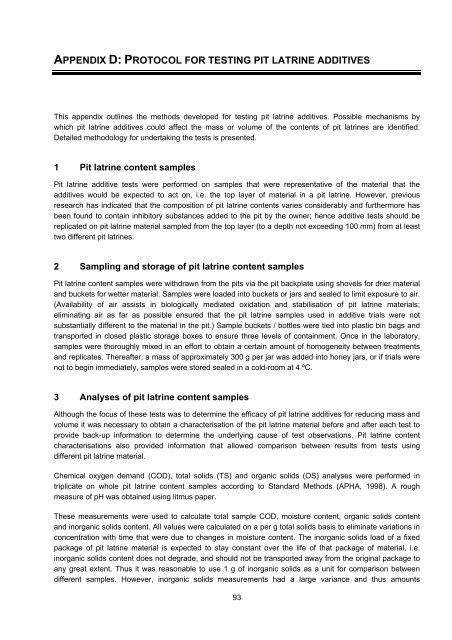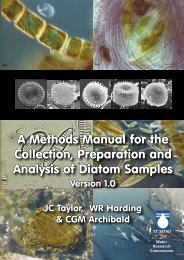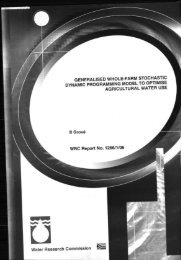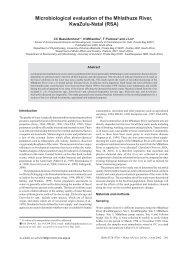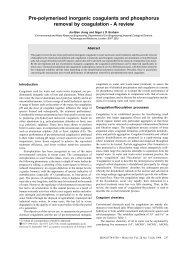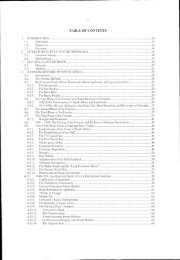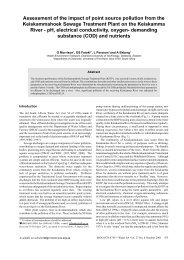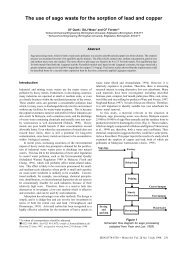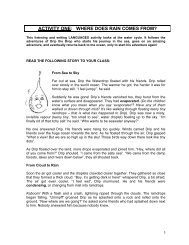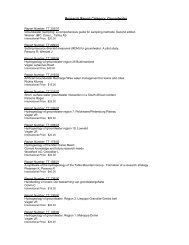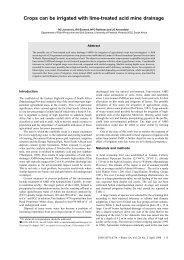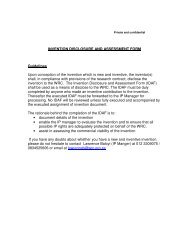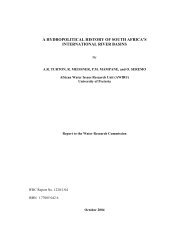and the Efficacy of Pit Latrine Additives - Water Research Commission
and the Efficacy of Pit Latrine Additives - Water Research Commission
and the Efficacy of Pit Latrine Additives - Water Research Commission
- No tags were found...
Create successful ePaper yourself
Turn your PDF publications into a flip-book with our unique Google optimized e-Paper software.
APPENDIX D: PROTOCOL FOR TESTING PIT LATRINE ADDITIVES<br />
This appendix outlines <strong>the</strong> methods developed for testing pit latrine additives. Possible mechanisms by<br />
which pit latrine additives could affect <strong>the</strong> mass or volume <strong>of</strong> <strong>the</strong> contents <strong>of</strong> pit latrines are identified.<br />
Detailed methodology for undertaking <strong>the</strong> tests is presented.<br />
1 <strong>Pit</strong> latrine content samples<br />
<strong>Pit</strong> latrine additive tests were performed on samples that were representative <strong>of</strong> <strong>the</strong> material that <strong>the</strong><br />
additives would be expected to act on, i.e. <strong>the</strong> top layer <strong>of</strong> material in a pit latrine. However, previous<br />
research has indicated that <strong>the</strong> composition <strong>of</strong> pit latrine contents varies considerably <strong>and</strong> fur<strong>the</strong>rmore has<br />
been found to contain inhibitory substances added to <strong>the</strong> pit by <strong>the</strong> owner; hence additive tests should be<br />
replicated on pit latrine material sampled from <strong>the</strong> top layer (to a depth not exceeding 100 mm) from at least<br />
two different pit latrines.<br />
2 Sampling <strong>and</strong> storage <strong>of</strong> pit latrine content samples<br />
<strong>Pit</strong> latrine content samples were withdrawn from <strong>the</strong> pits via <strong>the</strong> pit backplate using shovels for drier material<br />
<strong>and</strong> buckets for wetter material. Samples were loaded into buckets or jars <strong>and</strong> sealed to limit exposure to air.<br />
(Availability <strong>of</strong> air assists in biologically mediated oxidation <strong>and</strong> stabilisation <strong>of</strong> pit latrine materials;<br />
eliminating air as far as possible ensured that <strong>the</strong> pit latrine samples used in additive trials were not<br />
substantially different to <strong>the</strong> material in <strong>the</strong> pit.) Sample buckets / bottles were tied into plastic bin bags <strong>and</strong><br />
transported in closed plastic storage boxes to ensure three levels <strong>of</strong> containment. Once in <strong>the</strong> laboratory,<br />
samples were thoroughly mixed in an effort to obtain a certain amount <strong>of</strong> homogeneity between treatments<br />
<strong>and</strong> replicates. Thereafter, a mass <strong>of</strong> approximately 300 g per jar was added into honey jars, or if trials were<br />
not to begin immediately, samples were stored sealed in a cold-room at 4 ºC.<br />
3 Analyses <strong>of</strong> pit latrine content samples<br />
Although <strong>the</strong> focus <strong>of</strong> <strong>the</strong>se tests was to determine <strong>the</strong> efficacy <strong>of</strong> pit latrine additives for reducing mass <strong>and</strong><br />
volume it was necessary to obtain a characterisation <strong>of</strong> <strong>the</strong> pit latrine material before <strong>and</strong> after each test to<br />
provide back-up information to determine <strong>the</strong> underlying cause <strong>of</strong> test observations. <strong>Pit</strong> latrine content<br />
characterisations also provided information that allowed comparison between results from tests using<br />
different pit latrine material.<br />
Chemical oxygen dem<strong>and</strong> (COD), total solids (TS) <strong>and</strong> organic solids (OS) analyses were performed in<br />
triplicate on whole pit latrine content samples according to St<strong>and</strong>ard Methods (APHA, 1998). A rough<br />
measure <strong>of</strong> pH was obtained using litmus paper.<br />
These measurements were used to calculate total sample COD, moisture content, organic solids content<br />
<strong>and</strong> inorganic solids content. All values were calculated on a per g total solids basis to eliminate variations in<br />
concentration with time that were due to changes in moisture content. The inorganic solids load <strong>of</strong> a fixed<br />
package <strong>of</strong> pit latrine material is expected to stay constant over <strong>the</strong> life <strong>of</strong> that package <strong>of</strong> material, i.e.<br />
inorganic solids content does not degrade, <strong>and</strong> should not be transported away from <strong>the</strong> original package to<br />
any great extent. Thus it was reasonable to use 1 g <strong>of</strong> inorganic solids as a unit for comparison between<br />
different samples. However, inorganic solids measurements had a large variance <strong>and</strong> thus amounts<br />
93


